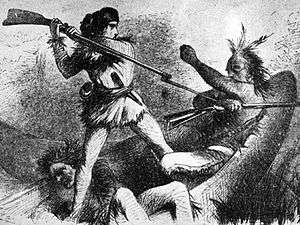Canoe Fight
The Americans, led by a brave soldier, Samuel Dale were currently understaffed due to the war with Great Britain. Dale had heard news of Indians near the southeastern bank of the Alabama River were armed. The crops in that area were ripe at the time, so they Indians needed to be out quick. Dale gathered together 72 men and boys to fight the Indians. Dale and his army set out on their journey towards the Alabama River. The Americans decided to split up their forces to find the Indians location quicker. One group of men, led by Jeremiah Austill discovered two canoes floating down the river and brought it to his commander, Dale. Dale and the rest of his army set out to cross the river and continue looking for Indians. When Dale discovered a small party of Indians he shot one of them and the rest fled. After searching the rest of the area Dale concluded the Indians were not there. He moved his army slowly over the river due to only having 2 small canoes. When Dale and a twelve other men had not crosses yet the Indians came back.
| Canoe Fight | |||||||
|---|---|---|---|---|---|---|---|
| Part of the Creek War | |||||||
 Samuel Dale in the Canoe Fight. | |||||||
| |||||||
| Belligerents | |||||||
|
| Creek | ||||||
| Commanders and leaders | |||||||
|
| unknown | ||||||
| Strength | |||||||
| 2 war-canoes | 1 war-canoe | ||||||
| Casualties and losses | |||||||
|
1 wounded 1 war-canoe damaged |
8 killed 1 mortally wounded 1 war-canoe captured | ||||||
How it Began
The Battle
The small pack of Americans hid behind rocks, bushes, and trees to stay safe. Dale knew they would not last much longer, so he tried to get help from the soldiers still on the other side. After few attempts nothing resulted and Dale knew he would only fight this battle with the twelve other men. Suddenly, a group of twelve Indian men came up from the river behind them and the situation got worse. Only nine of the twelve fought with Dale as one of them fled and the other was shot. Dale got together three other men, Jerry Austill, James Smith, and Caesar. These four men went head on with the large Indian boat. Caesar controlled the boats while the rest fought. Caesar made sure the boat was in the right position so only a few men could strike at a time. The gunpowder got wet so hand held weapons had to be used. Dale and his men slowly destroyed each an every one of the Indian men. Despite awful odds, the Americans came out on top.
Aftermath
When the battle had finished some of his army was still in danger stuck on the other side of the river. Dale and his other officers had to take each and every one of the dead Indian men off of the boat to save his men. This task was a horrible experience and not a good way to end a battle due to the brains, blood, and hair covering the boat. After this long hard day, Dales work was finally done and his army was safe. After searching for the rest of the Indians later that night Dale determined they were gone.
See also
References
Template:The History of Alabama and Incidentally of Georgia and Mississippi, from the Earliest Period